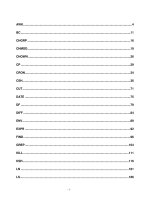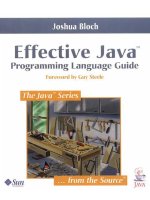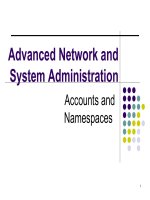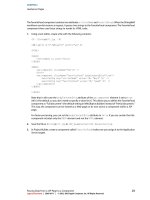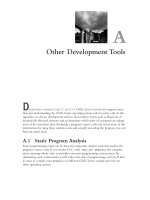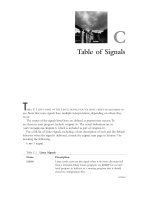Tài liệu Advanced Linux Programming: 6-Mastering Linux ppt
Bạn đang xem bản rút gọn của tài liệu. Xem và tải ngay bản đầy đủ của tài liệu tại đây (262.52 KB, 20 trang )
Mastering Linux
II
6 Devices
7 The /proc File System
8 Linux System Calls
9 Inline Assembly Code
10 Security
11 A Sample GNU/Linux Application
07 0430 PT02 5/22/01 10:34 AM Page 127
07 0430 PT02 5/22/01 10:34 AM Page 128
Devices
6
LINUX, LIKE MOST OPERATING SYSTEMS, INTERACTS WITH HARDWARE devices via
modularized software components called device drivers. A device driver hides the pecu-
liarities of a hardware device’s communication protocols from the operating system
and allows the system to interact with the device through a standardized interface.
Under Linux, device drivers are part of the kernel and may be either linked stati-
cally into the kernel or loaded on demand as kernel modules. Device drivers run as
part of the kernel and aren’t directly accessible to user processes. However, Linux pro-
vides a mechanism by which processes can communicate with a device driver—and
through it with a hardware device—via file-like objects.These objects appear in the
file system, and programs can open them, read from them, and write to them practi-
cally as if they were normal files. Using either Linux’s low-level I/O operations (see
Appendix B,“Low-Level I/O”) or the standard C library’s I/O operations, your pro-
grams can communicate with hardware devices through these file-like objects.
Linux also provides several file-like objects that communicate directly with the
kernel rather than with device drivers.These aren’t linked to hardware devices; instead,
they provide various kinds of specialized behavior that can be of use to application and
system programs.
08 0430 CH06 5/22/01 10:29 AM Page 129
130
Chapter 6 Devices
Exercise Caution When Accessing Devices!
The techniques in this chapter provide direct access to device drivers running in the Linux kernel, and
through them to hardware devices connected to the system. Use these techniques with care because mis-
use can cause impair or damage the GNU/Linux system.
See especially the sidebar “Dangers of Block Devices.”
6.1 Device Types
Device files aren’t ordinary files—they do not represent regions of data on a disk-
based file system. Instead, data read from or written to a device file is communicated
to the corresponding device driver, and from there to the underlying device. Device
files come in two flavors:
n
A character device represents a hardware device that reads or writes a serial stream
of data bytes. Serial and parallel ports, tape drives, terminal devices, and sound
cards are examples of character devices.
n
A block device represents a hardware device that reads or writes data in fixed-size
blocks. Unlike a character device, a block device provides random access to data
stored on the device. A disk drive is an example of a block device.
Typical application programs will never use block devices.While a disk drive is repre-
sented as block devices, the contents of each disk partition typically contain a file sys-
tem, and that file system is mounted into GNU/Linux’s root file system tree. Only the
kernel code that implements the file system needs to access the block device directly;
application programs access the disk’s contents through normal files and directories.
Dangers of Block Devices
Block devices provide direct access to disk drive data. Although most GNU/Linux systems are configured
to prevent nonroot processes from accessing these devices directly, a root process can inflict severe dam-
age by changing the contents of the disk. By writing to a disk block device, a program can modify or
destroy file system control information and even a disk’s partition table and master boot record, thus
rendering a drive or even the entire system unusable. Always access these devices with great care.
Applications sometimes make use of character devices, though.We’ll discuss several
of them in the following sections.
6.2 Device Numbers
Linux identifies devices using two numbers: the major device number and the minor device
number.The major device number specifies which driver the device corresponds to.
The correspondence from major device numbers to drivers is fixed and part of the
Linux kernel sources. Note that the same major device number may correspond to
08 0430 CH06 5/22/01 10:29 AM Page 130
131
6.3 Device Entries
two different drivers, one a character device and one a block device. Minor device
numbers distinguish individual devices or components controlled by a single driver.
The meaning of a minor device number depends on the device driver.
For example, major device no. 3 corresponds to the primary IDE controller on the
system. An IDE controller can have two devices (disk, tape, or CD-ROM drives)
attached to it; the “master” device has minor device no. 0, and the “slave” device has
minor device no. 64. Individual partitions on the master device (if the device supports
partitions) are represented by minor device numbers 1, 2, 3, and so on. Individual parti-
tions on the slave device are represented by minor device numbers 65, 66, 67, and so on.
Major device numbers are listed in the Linux kernel sources documentation.
On many GNU/Linux distributions, this documentation can be found in
/usr/src/linux/Documentation/devices.txt.The special entry /proc/devices lists
major device numbers corresponding to active device drivers currently loaded into the
kernel. (See Chapter 7, “The /proc File System,” for more information about /proc
file system entries.)
6.3 Device Entries
A device entry is in many ways the same as a regular file.You can move it using the mv
command and delete it using the rm command. If you try to copy a device entry using
cp, though, you’ll read bytes from the device (if the device supports reading) and write
them to the destination file. If you try to overwrite a device entry, you’ll write bytes to
the corresponding device instead.
You can create a device entry in the file system using the mknod command (invoke
man 1 mknod for the man page) or the mknod system call (invoke man 2 mknod for the
man page). Creating a device entry in the file system doesn’t automatically imply that
the corresponding device driver or hardware device is present or available; the device
entry is merely a portal for communicating with the driver, if it’s there. Only superuser
processes can create block and character devices using the mknod command or the
mknod system call.
To create a device using the
mknod command, specify as the first argument the path
at which the entry will appear in the file system. For the second argument, specify b
for a block device or c for a character device. Provide the major and minor device
numbers as the third and fourth arguments, respectively. For example, this command
makes a character device entry named lp0 in the current directory.The device has
major device no. 6 and minor device no. 0.These numbers correspond to the first par-
allel port on the Linux system.
% mknod ./lp0 c 6 0
08 0430 CH06 5/22/01 10:29 AM Page 131
132
Chapter 6 Devices
Remember that only superuser processes can create block and character devices, so
you must be logged in as root to invoke this command successfully.
The ls command displays device entries specially. If you invoke ls with the -l or
-o options, the first character on each line of output specifies the type of the entry.
Recall that - (a hyphen) designates a normal file, while d designates a directory.
Similarly, b designates a block device, and c designates a character device. For the latter
two, ls prints the major and minor device numbers where it would the size of an
ordinary file. For example, we can display the block device that we just created:
% ls -l lp0
crw-r 1 root root 6, 0 Mar 7 17:03 lp0
In a program, you can determine whether a file system entry is a block or character
device and then retrieve its device numbers using stat. See Section B.2,“stat,” in
Appendix B, for instructions.
To remove the entry, use rm.This doesn’t remove the device or device driver; it
simply removes the device entry from the file system.
% rm ./lp0
6.3.1 The /dev Directory
By convention, a GNU/Linux system includes a directory /dev containing the full
complement of character and block device entries for devices that Linux knows about.
Entries in /dev have standardized names corresponding to major and minor device
numbers.
For example, the master device attached to the primary IDE controller, which has
major and minor device numbers 3 and 0, has the standard name /dev/hda. If this
device supports partitions, the first partition on it, which has minor device no. 1, has
the standard name /dev/hda1.You can check that this is true on your system:
% ls -l /dev/hda /dev/hda1
brw-rw 1 root disk 3, 0 May 5 1998 /dev/hda
brw-rw 1 root disk 3, 1 May 5 1998 /dev/hda1
Similarly, /dev has an entry for the parallel port character device that we used
previously:
% ls -l /dev/lp0
crw-rw 1 root daemon 6, 0 May 5 1998 /dev/lp0
In most cases, you should not use mknod to create your own device entries. Use the
entries in /dev instead. Non-superuser programs have no choice but to use preexisting
device entries because they cannot create their own.Typically, only system administra-
tors and developers working with specialized hardware devices will need to create
device entries. Most GNU/Linux distributions include facilities to help system
administrators create standard device entries with the correct names.
08 0430 CH06 5/22/01 10:29 AM Page 132
133
6.4 Hardware Devices
6.3.2 Accessing Devices by Opening Files
How do you use these devices? In the case of character devices, it can be quite simple:
Open the device as if it were a normal file, and read from or write to it.You can even
use normal file commands such as cat, or your shell’s redirection syntax, to send data
to or from the device.
For example, if you have a printer connected to your computer’s first parallel port,
you can print files by sending them directly to /dev/lp0.
1
To print the contents of
document.txt, invoke the following:
% cat document.txt > /dev/lp0
You must have permission to write to the device entry for this to succeed; on many
GNU/Linux systems, the permissions are set so that only root and the system’s printer
daemon (lpd) can write to the file.Also, what comes out of your printer depends on
how your printer interprets the contents of the data you send it. Some printers will
print plain text files that are sent to them,
2
while others will not. PostScript printers
will render and print PostScript files that you send to them.
In a program, sending data to a device is just as simple. For example, this code frag-
ment uses low-level I/O functions to send the contents of a buffer to
/dev/lp0.
int fd = open (“/dev/lp0”, O_WRONLY);
write (fd, buffer, buffer_length);
close (fd);
6.4 Hardware Devices
Some common block devices are listed in Table 6.1. Device numbers for similar
devices follow the obvious pattern (for instance, the second partition on the first SCSI
drive is /dev/sda2). It’s occasionally useful to know which devices these device names
correspond to when examining mounted file systems in /proc/mounts (see Section
7.5,“Drives, Mounts, and File Systems,” in Chapter 7, for more about this).
Table 6.1 Partial Listing of Common Block Devices
Device Name Major Minor
First floppy drive
/dev/fd0 20
Second floppy drive
/dev/fd1 21
Primary IDE controller, master device
/dev/hda 30
Primary IDE controller, master device,
/dev/hda1 31
first partition
1. Windows users will recognize that this device is similar to the magic Windows file
LPR1.
2. Your printer may require explicit carriage return characters, ASCII code 14, at the end of
each line, and may require a form feed character, ASCII code 12, at the end of each page.
continues
08 0430 CH06 5/22/01 10:29 AM Page 133
134
Chapter 6 Devices
Primary IDE controller, secondary device
/dev/hdb 364
Primary IDE controller, secondary device,
/dev/hdb1 365
first partition
Secondary IDE controller, master device
/dev/hdc 22 0
Secondary IDE controller, secondary device
/dev/hdd 22 64
First SCSI drive
/dev/sda 80
First SCSI drive, first partition
/dev/sda1 81
Second SCSI disk
/dev/sdb 816
Second SCSI disk, first partition
/dev/sdb1 817
First SCSI CD-ROM drive
/dev/scd0 11 0
Second SCSI CD-ROM drive /dev/scd1 11 1
Table 6.2 lists some common character devices.
Table 6.2 Some Common Character Devices
Device Name Major Minor
Parallel port 0
/dev/lp0 or /dev/par0 60
Parallel port 1
/dev/lp1 or /dev/par1 61
First serial port
/dev/ttyS0 464
Second serial port
/dev/ttyS1 465
IDE tape drive
/dev/ht0 37 0
First SCSI tape drive
/dev/st0 90
Second SCSI tape drive
/dev/st1 91
System console
/dev/console 51
First virtual terminal
/dev/tty1 41
Second virtual terminal
/dev/tty2 42
Process’s current terminal device
/dev/tty 50
Sound card /dev/audio 14 4
You can access certain hardware components through more than one character device;
often, the different character devices provide different semantics. For example, when
you use the IDE tape device /dev/ht0, Linux automatically rewinds the tape in the
drive when you close the file descriptor.You can use the device /dev/nht0 to access
the same tape drive, except that Linux will not automatically rewind the tape when
you close the file descriptor.You sometimes might see programs using /dev/cua0 and
similar devices; these are older interfaces to serial ports such as /dev/ttyS0.
Table 6.1 Continued
Device Name Major Minor
08 0430 CH06 5/22/01 10:29 AM Page 134
135
6.4 Hardware Devices
Occasionally, you’ll want to write data directly to character devices—for example:
n
A terminal program might access a modem directly through a serial port device.
Data written to or read from the devices is transmitted via the modem to a
remote computer.
n
A tape backup program might write data directly to a tape device.The backup
program could implement its own compression and error-checking format.
n
A program can write directly to the first virtual terminal
3
writing data to
/dev/tty1.
Terminal windows running in a graphical environment, or remote login terminal
sessions, are not associated with virtual terminals; instead, they’re associated with
pseudo-terminals. See Section 6.6,“PTYs,” for information about these.
n
Sometimes a program needs to access the terminal device with which it is
associated.
For example, your program may need to prompt the user for a password. For
security reasons, you might want to ignore redirection of standard input and
output and always read the password from the terminal, no matter how the user
invokes the command. One way to do this is to open /dev/tty, which always
corresponds to the terminal device associated with the process that opens it.
Write the prompt message to that device, and read the password from it. By
ignoring standard input and output, this prevents the user from feeding your
program a password from a file using shell syntax such as this:
% secure_program < my-password.txt
If you need to authenticate users in your program, you should learn about
GNU/Linux’s PAM facility. See Section 10.5,“Authenticating Users,” in
Chapter 10,“Security,” for more information.
n
A program can play sounds through the system’s sound card by sending audio
data to /dev/audio. Note that the audio data must be in Sun audio format (usu-
ally associated with the .au extension).
For example, many GNU/Linux distributions come with the classic sound file
/usr/share/sndconfig/sample.au. If your system includes this file, try playing it
by invoking the following:
% cat /usr/share/sndconfig/sample.au > /dev/audio
If you’re planning on using sound in your program, though, you should investi-
gate the various sound libraries and services available for GNU/Linux.The
Gnome windowing environment uses the Enlightenment Sound Daemon
(EsounD), at KDE uses aRts, at
If you use one of these
sound systems instead of writing directly to /dev/audio, your program will
cooperate better with other programs that use the computer’s sound card.
3. On most GNU/Linux systems, you can switch to the first virtual terminal by pressing
Ctrl+Alt+F1. Use Ctrl+Alt+F2 for the second virtual terminal, and so on.
08 0430 CH06 5/22/01 10:29 AM Page 135
136
Chapter 6 Devices
6.5 Special Devices
Linux also provides several character devices that don’t correspond to hardware
devices.These entries all use the major device no. 1, which is associated with the
Linux kernel’s memory device instead of a device driver.
6.5.1 /dev/null
The entry /dev/null, the null device, is very handy. It serves two purposes; you are
probably familiar at least with the first one:
n
Linux discards any data written to /dev/null. A common trick is to specify
/dev/null as an output file in some context where the output is unwanted.
For example, to run a command and discard its standard output (without print-
ing it or writing it to a file), redirect standard output to /dev/null:
% verbose_command > /dev/null
n
Reading from /dev/null always results in an end-of-file. For instance, if you
open a file descriptor to /dev/null using open and then attempt to read from
the file descriptor, read will read no bytes and will return 0. If you copy from
/dev/null to another file, the destination will be a zero-length file:
% cp /dev/null empty-file
% ls -l empty-file
-rw-rw 1 samuel samuel 0 Mar 8 00:27 empty-file
6.5.2 /dev/zero
The device entry /dev/zero behaves as if it were an infinitely long file filled with 0
bytes.As much data as you’d try to read from /dev/zero, Linux “generates” enough 0
bytes.
To illustrate this, let’s run the hex dump program presented in Listing B.4 in
Section B.1.4,“Reading Data,” of Appendix B.This program prints the contents of a
file in hexadecimal form.
% ./hexdump /dev/zero
0x000000 : 00 00 00 00 00 00 00 00 00 00 00 00 00 00 00 00
0x000010 : 00 00 00 00 00 00 00 00 00 00 00 00 00 00 00 00
0x000020 : 00 00 00 00 00 00 00 00 00 00 00 00 00 00 00 00
0x000030 : 00 00 00 00 00 00 00 00 00 00 00 00 00 00 00 00
Hit Ctrl+C when you’re convinced that it will go on indefinitely.
Memory mapping /dev/zero is an advanced technique for allocating memory. See
Section 5.3.5,“Other Uses for mmap,” in Chapter 5,“Interprocess Communication,” for
more information, and see the sidebar “Obtaining Page-Aligned Memory” in Section
8.9,“mprotect: Setting Memory Permissions,” in Chapter 8,“Linux System Calls,” for
an example.
08 0430 CH06 5/22/01 10:29 AM Page 136
137
6.5 Special Devices
6.5.3 /dev/full
The entry /dev/full behaves as if it were a file on a file system that has no more
room. A write to /dev/full fails and sets errno to ENOSPC, which ordinarily indicates
that the written-to device is full.
For example, you can try to write to /dev/full using the cp command:
% cp /etc/fstab /dev/full
cp: /dev/full: No space left on device
The /dev/full entry is primarily useful to test how your program behaves if it runs
out of disk space while writing to a file.
6.5.4 Random Number Devices
The special devices /dev/random and /dev/urandom provide access to the Linux ker-
nel’s built-in random number–generation facility.
Most software functions for generating random numbers, such as the rand function
in the standard C library, actually generate pseudorandom numbers. Although these
numbers satisfy some properties of random numbers, they are reproducible: If you start
with the same seed value, you’ll obtain the same sequence of pseudorandom numbers
every time.This behavior is inevitable because computers are intrinsically deterministic
and predictable. For certain applications, though, this behavior is undesirable; for
instance, it is sometimes possible to break a cryptographic algorithm if you can obtain
the sequence of random numbers that it employs.
To obtain better random numbers in computer programs requires an external
source of randomness.The Linux kernel harnesses a particularly good source of
randomness: you! By measuring the time delay between your input actions, such as
keystrokes and mouse movements, Linux is capable of generating an unpredictable
stream of high-quality random numbers.You can access this stream by reading from
/dev/random and /dev/urandom.The data that you read is a stream of randomly
generated bytes.
The difference between the two devices exhibits itself when Linux exhausts its
store of randomness. If you try to read a large number of bytes from
/dev/random but
don’t generate any input actions (you don’t type, move the mouse, or perform a similar
action), Linux blocks the read operation. Only when you provide some randomness
does Linux generate some more random bytes and return them to your program.
For example, try displaying the contents of
/dev/random using the od command.
4
Each row of output shows 16 random bytes.
4.We use od here instead of the hexdump program presented in Listing B.4, even though they
do pretty much the same thing, because
hexdump terminates when it runs out of data, while od
waits for more data to become available.The -t x1 option tells od to print file contents in
hexadecimal.
08 0430 CH06 5/22/01 10:29 AM Page 137
138
Chapter 6 Devices
% od -t x1 /dev/random
0000000 2c 9c 7a db 2e 79 3d 65 36 c2 e3 1b 52 75 1e 1a
0000020 d3 6d 1e a7 91 05 2d 4d c3 a6 de 54 29 f4 46 04
0000040 b3 b0 8d 94 21 57 f3 90 61 dd 26 ac 94 c3 b9 3a
0000060 05 a3 02 cb 22 0a bc c9 45 dd a6 59 40 22 53 d4
The number of lines of output that you see will vary—there may be quite a few—but
the output will eventually pause when Linux exhausts its store of randomness. Now
try moving your mouse or typing on the keyboard, and watch additional random
numbers appear. For even better randomness, let your cat walk on the keyboard.
A read from /dev/urandom, in contrast, will never block. If Linux runs out of ran-
domness, it uses a cryptographic algorithm to generate pseudorandom bytes from the
past sequence of random bytes.Although these bytes are random enough for many
purposes, they don’t pass as many tests of randomness as those obtained from
/dev/random.
For instance, if you invoke the following, the random bytes will fly by forever, until
you kill the program with Ctrl+C:
% od -t x1 /dev/urandom
0000000 62 71 d6 3e af dd de 62 c0 42 78 bd 29 9c 69 49
0000020 26 3b 95 bc b9 6c 15 16 38 fd 7e 34 f0 ba ce c3
0000040 95 31 e5 2c 8d 8a dd f4 c4 3b 9b 44 2f 20 d1 54
Using random numbers from /dev/random in a program is easy, too. Listing 6.1
presents a function that generates a random number using bytes read from in
/dev/random. Remember that /dev/random blocks a read until there is enough ran-
domness available to satisfy it; you can use /dev/urandom instead if fast execution is
more important and you can live with the potential lower quality of random numbers.
Listing 6.1 (random_number.c) Function to Generate a Random Number
Using /dev/random
#include <assert.h>
#include <sys/stat.h>
#include <sys/types.h>
#include <fcntl.h>
#include <unistd.h>
/* Return a random integer between MIN and MAX, inclusive. Obtain
randomness from /dev/random. */
int random_number (int min, int max)
{
/* Store a file descriptor opened to /dev/random in a static
variable. That way, we don’t need to open the file every time
this function is called. */
static int dev_random_fd = -1;
08 0430 CH06 5/22/01 10:29 AM Page 138
139
6.5 Special Devices
char* next_random_byte;
int bytes_to_read;
unsigned random_value;
/* Make sure MAX is greater than MIN. */
assert (max > min);
/* If this is the first time this function is called, open a file
descriptor to /dev/random. */
if (dev_random_fd == -1) {
dev_random_fd = open (“/dev/random”, O_RDONLY);
assert (dev_random_fd != -1);
}
/* Read enough random bytes to fill an integer variable. */
next_random_byte = (char*) &random_value;
bytes_to_read = sizeof (random_value);
/* Loop until we’ve read enough bytes. Because /dev/random is filled
from user-generated actions, the read may block and may only
return a single random byte at a time. */
do {
int bytes_read;
bytes_read = read (dev_random_fd, next_random_byte, bytes_to_read);
bytes_to_read -= bytes_read;
next_random_byte += bytes_read;
} while (bytes_to_read > 0);
/* Compute a random number in the correct range. */
return min + (random_value % (max - min + 1));
}
6.5.5 Loopback Devices
A loopback device enables you to simulate a block device using an ordinary disk file.
Imagine a disk drive device for which data is written to and read from a file named
disk-image rather than to and from the tracks and sectors of an actual physical disk
drive or disk partition. (Of course, the file disk-image must reside on an actual disk,
which must be larger than the simulated disk.) A loopback device enables you to use a
file in this manner.
Loopback devices are named /dev/loop0, /dev/loop1, and so on. Each can be used
to simulate a single block device at one time. Note that only the superuser can set up
a loopback device.
A loopback device can be used in the same way as any other block device. In
particular, you can construct a file system on the device and then mount that file sys-
tem as you would mount the file system on an ordinary disk or partition. Such a file
system, which resides in its entirety within an ordinary disk file, is called a virtual file
system.
08 0430 CH06 5/22/01 10:29 AM Page 139
140
Chapter 6 Devices
To construct a virtual file system and mount it with a loopback device, follow
these steps:
1. Create an empty file to hold the virtual file system.The size of the file will be
the apparent size of the loopback device after it is mounted.
One convenient way to construct a file of a fixed size is with the dd command.
This command copies blocks (by default, 512 bytes each) from one file to
another.The /dev/zero file is a convenient source of bytes to copy from.
To construct a 10MB file named disk-image, invoke the following:
% dd if=/dev/zero of=/tmp/disk-image count=20480
20480+0 records in
20480+0 records out
% ls -l /tmp/disk-image
-rw-rw 1 root root 10485760 Mar 8 01:56 /tmp/disk-image
2. The file that you’ve just created is filled with 0 bytes. Before you mount it, you
must construct a file system.This sets up the various control structures needed to
organize and store files, and builds the root directory.
You can build any type of file system you like in your disk image.To construct
an ext2 file system (the type most commonly used for Linux disks), use the
mke2fs command. Because it’s usually run on a block device, not an ordinary
file, it asks for confirmation:
% mke2fs -q /tmp/disk-image
mke2fs 1.18, 11-Nov-1999 for EXT2 FS 0.5b, 95/08/09
disk-image is not a block special device.
Proceed anyway? (y,n) y
The -q option suppresses summary information about the newly created file
system. Leave this option out if you’re curious about it.
Now disk-image contains a brand-new file system, as if it were a freshly
initialized 10MB disk drive.
08 0430 CH06 5/22/01 2:37 PM Page 140
141
6.5 Special Devices
3. Mount the file system using a loopback device.To do this, use the mount
command, specifying the disk image file as the mount device.Also specify
loop=loopback-device as a mount option, using the -o option to mount to tell
mount which loopback device to use.
For example, to mount our disk-image file system, invoke these commands.
Remember, only the superuser may use a loopback device.The first command
creates a directory, /tmp/virtual-fs, to use as the mount point for the virtual
file system.
% mkdir /tmp/virtual-fs
% mount -o loop=/dev/loop0 /tmp/disk-image /tmp/virtual-fs
Now your disk image is mounted as if it were an ordinary 10MB disk drive.
% df -h /tmp/virtual-fs
Filesystem Size Used Avail Use% Mounted on
/tmp/disk-image 9.7M 13k 9.2M 0% /tmp/virtual-fs
You can use it like any other disk:
% cd /tmp/virtual-fs
% echo ‘Hello, world!’ > test.txt
% ls -l
total 13
drwxr-xr-x 2 root root 12288 Mar 8 02:00 lost+found
-rw-rw 1 root root 14 Mar 8 02:12 test.txt
% cat test.txt
Hello, world!
Note that lost+found is a directory that was automatically added by mke2fs.
5
5. If the file system is ever damaged, and some data is recovered but not associated with a
file, it is placed in
lost+found.
08 0430 CH06 5/22/01 2:37 PM Page 141
142
Chapter 6 Devices
When you’re done, unmount the virtual file system.
% cd /tmp
% umount /tmp/virtual-fs
You can delete disk-image if you like, or you can mount it later to access the
files on the virtual file system.You can also copy it to another computer and
mount it there—the whole file system that you created on it will be intact.
Instead of creating a file system from scratch, you can copy one directly from a device.
For instance, you can create an image of the contents of a CD-ROM simply by
copying it from the CD-ROM device.
If you have an IDE CD-ROM drive, use the corresponding device name, such as
/dev/hda, described previously. If you have a SCSI CD-ROM drive, the device name
will be /dev/scd0 or similar.Your system may also have a symbolic link /dev/cdrom
that points to the appropriate device. Consult your /etc/fstab file to determine what
device corresponds to your computer’s CD-ROM drive.
Simply copy that device to a file.The resulting file will be a complete disk image of
the file system on the CD-ROM in the drive—for example:
% cp /dev/cdrom /tmp/cdrom-image
This may take several minutes, depending on the CD-ROM you’re copying and the
speed of your drive.The resulting image file will be quite large—as large as the con-
tents of the CD-ROM.
Now you can mount this CD-ROM image without having the original CD-ROM
in the drive. For example, to mount it on /mnt/cdrom, use this line:
% mount -o loop=/dev/loop0 /tmp/cdrom-image /mnt/cdrom
Because the image is on a hard disk drive, it’ll perform much faster than the actual
CD-ROM disk. Note that most CD-ROMs use the file system type iso9660.
6.6 PTYs
If you run the mount command with no command-line arguments, which displays
the file systems mounted on your system, you’ll notice a line that looks something
like this:
none on /dev/pts type devpts (rw,gid=5,mode=620)
This indicates that a special type of file system, devpts, is mounted at /dev/pts.This
file system, which isn’t associated with any hardware device, is a “magic” file system
that is created by the Linux kernel. It’s similar to the
/proc file system; see Chapter 7
for more information about how this works.
08 0430 CH06 5/22/01 2:37 PM Page 142
143
6.6 PTYs
Like the /dev directory, /dev/pts contains entries corresponding to devices. But
unlike /dev, which is an ordinary directory, /dev/pts is a special directory that is cre-
ated dynamically by the Linux kernel.The contents of the directory vary with time
and reflect the state of the running system.
The entries in /dev/pts correspond to pseudo-terminals (or pseudo-TTYs, or PTYs).
Linux creates a PTY for every new terminal window you open and displays a corre-
sponding entry in /dev/pts.The PTY device acts like a terminal device—it accepts
input from the keyboard and displays text output from the programs that run in it.
PTYs are numbered, and the PTY number is the name of the corresponding entry in
/dev/pts.
You can display the terminal device associated with a process using the
ps com-
mand. Specify tty as one of the fields of a custom format with the -o option.To dis-
play the process ID,TTY, and command line of each process sharing the same
terminal, invoke ps -o pid,tty,cmd.
6.6.1 A PTY Demonstration
For example, you can determine the PTY associated with a given terminal window by
invoking in the window this command:
% ps -o pid,tty,cmd
PID TT CMD
28832 pts/4 bash
29287 pts/4 ps -o pid,tty,cmd
This particular terminal window is running in PTY 4.
The PTY has a corresponding entry in /dev/pts:
% ls -l /dev/pts/4
crw w 1 samuel tty 136, 4 Mar 8 02:56 /dev/pts/4
Note that it is a character device, and its owner is the owner of the process for which
it was created.
You can read from or write to the PTY device. If you read from it, you’ll hijack
keyboard input that would otherwise be sent to the program running in the PTY. If
you write to it, the data will appear in that window.
Try opening a new terminal window, and determine its PTY number by invoking
ps -o pid,tty,cmd. From another window, write some text to the PTY device. For
example, if the new terminal window’s PTY number is 7, invoke this command from
another window:
% echo ‘Hello, other window!’ > /dev/pts/7
The output appears in the new terminal window. If you close the new terminal win-
dow, the entry 7 in /dev/pts disappears.
08 0430 CH06 5/22/01 10:29 AM Page 143
144
Chapter 6 Devices
If you invoke ps to determine the TTY from a text-mode virtual terminal (press
Ctrl+Alt+F1 to switch to the first virtual terminal, for instance), you’ll see that it’s
running in an ordinary terminal device instead of a PTY:
% ps -o pid,tty,cmd
PID TT CMD
29325 tty1 -bash
29353 tty1 ps -o pid,tty,cmd
6.7 ioctl
The ioctl system call is an all-purpose interface for controlling hardware devices.The
first argument to ioctl is a file descriptor, which should be opened to the device that
you want to control.The second argument is a request code that indicates the opera-
tion that you want to perform.Various request codes are available for different devices.
Depending on the request code, there may be additional arguments supplying data
to ioctl.
Many of the available requests codes for various devices are listed in the ioctl_list
man page. Using ioctl generally requires a detailed understanding of the device driver
corresponding to the hardware device that you want to control. Most of these are
quite specialized and are beyond the scope of this book. However, we’ll present one
example to give you a taste of how ioctl is used.
Listing 6.2 (cdrom-eject.c) Eject a CD-ROM
#include <fcntl.h>
#include <linux/cdrom.h>
#include <sys/ioctl.h>
#include <sys/stat.h>
#include <sys/types.h>
#include <unistd.h>
int main (int argc, char* argv[])
{
/* Open a file descriptor to the device specified on the command line. */
int fd = open (argv[1], O_RDONLY);
/* Eject the CD-ROM. */
ioctl (fd, CDROMEJECT);
/* Close the file descriptor. */
close (fd);
return 0;
}
08 0430 CH06 5/22/01 10:29 AM Page 144
145
6.7 ioctl
Listing 6.2 presents a short program that ejects the disk in a CD-ROM drive (if the
drive supports this). It takes a single command-line argument, the CD-ROM drive
device. It opens a file descriptor to the device and invokes ioctl with the request
code CDROMEJECT.This request, defined in the header <linux/cdrom.h>, instructs the
device to eject the disk.
For example, if your system has an IDE CD-ROM drive connected as the master
device on the secondary IDE controller, the corresponding device is /dev/hdc.To eject
the disk from the drive, invoke this line:
% ./cdrom-eject /dev/hdc
08 0430 CH06 5/22/01 10:29 AM Page 145
08 0430 CH06 5/22/01 10:29 AM Page 146
